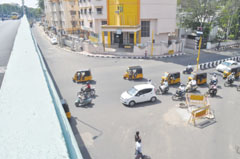Time to consider other solutions
Chennai now has 15 flyovers, the two newest at Turnbull’s Road and Perambur, having been declared open in December. There are plans for three more – at Mint, Tiruvanmiyur and T’Nagar. The Chennai Corporation has declared that all the flyovers are successes and are used by 29 lakh vehicles. A mobility survey has said that the rate of traffic movement in Chennai is better than in other metropolitan cities in India. But is it all true? Ground reality would seem otherwise, barring one or two cases.

The narrow side lane next to the Cenotaph road flyover. |
Most flyovers have only eliminated the problem at particular hot spots. The traffic generally moves smoothly over the flyovers but gets congested at the landing points from the ramps. The previous and subsequent traffic intersections are not being upgraded, and as for the service lanes beside the flyovers, these are practically unusable. Wherever the flyovers are constructed, the road space below, which earlier used to accommodate four lanes, gets reduced to two lanes, one lane for each side. The space under the flyover is often not put to any practical use and this further reduces road space. Consequently, traffic slows down on the side roads and long serpentine queues build up, particularly during peak traffic hours. In some cases, the flyovers themselves are so narrow that buses and heavy vehicles are not allowed on them, thereby choking the side lanes further. The absence of a comprehensive traffic plan for the entire city is quite obvious, with all the flyovers being thought of as a one-point solution.
Most flyovers have necessitated the widening of the roads on which they are built with land being acquired from the private owners on either side. True, compensation has been paid at market rates, but this is not a matter that concerns money alone. Many of these buildings are now abutting the road and erstwhile parking spaces have vanished. The vehicles that belong to those who live/work in these buildings are now parked on the road, thereby further choking the traffic. The CMDA and the Corporation have not been able to fix a uniform building line along most arterial roads and this further hampers free traffic flow.
Pavements have become a direct casualty with the construction of flyovers. Most pavements are now only 6-18 inches wide and are most pedestrian-unfriendly. Utilities such as transformers and electric junction boxes fight for the same space as the pedestrian. At such places, pedestrians are forced to use the roads, competing for the same space as the vehicles. All this makes for a dangerous cocktail.
It is clear that flyovers have been built entirely to suit a small section of the city’s population – those who travel by private vehicles. The entire city’s landscape is being altered to suit this segment and to enable it to travel faster. But even that does not happen often.
On the Turnbull’s Road flyover, for instance, peak hour traffic in the evening stretches from the Kotturpuram side of the flyover to the Cenotaph Road-Mount Road junction and in the morning from the Cenotaph Road side of the flyover to the Kotturpuram bridge, all traffic virtually remaining stationary.
In such circumstances, are flyovers the answer? Only the Corporation traffic planners seem to think so. The public view as well as that of other traffic planners is quite different.
|